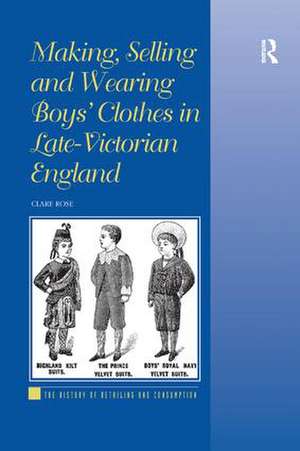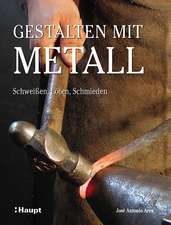Making, Selling and Wearing Boys' Clothes in Late-Victorian England: The History of Retailing and Consumption
Autor Clare Roseen Limba Engleză Paperback – 28 noi 2016
| Toate formatele și edițiile | Preț | Express |
|---|---|---|
| Paperback (1) | 468.36 lei 6-8 săpt. | |
| Taylor & Francis – 28 noi 2016 | 468.36 lei 6-8 săpt. | |
| Hardback (1) | 1113.95 lei 6-8 săpt. | |
| Taylor & Francis – 28 sep 2010 | 1113.95 lei 6-8 săpt. |
Preț: 468.36 lei
Nou
Puncte Express: 703
Preț estimativ în valută:
89.62€ • 93.58$ • 74.00£
89.62€ • 93.58$ • 74.00£
Carte tipărită la comandă
Livrare economică 15-29 aprilie
Preluare comenzi: 021 569.72.76
Specificații
ISBN-13: 9781138261860
ISBN-10: 1138261866
Pagini: 294
Dimensiuni: 156 x 234 mm
Greutate: 0.43 kg
Ediția:1
Editura: Taylor & Francis
Colecția Routledge
Seria The History of Retailing and Consumption
Locul publicării:Oxford, United Kingdom
ISBN-10: 1138261866
Pagini: 294
Dimensiuni: 156 x 234 mm
Greutate: 0.43 kg
Ediția:1
Editura: Taylor & Francis
Colecția Routledge
Seria The History of Retailing and Consumption
Locul publicării:Oxford, United Kingdom
Cuprins
Contents: Introduction; Raggedness and respectability; Designing boys' clothes; Advertising boys' clothes; Affording boys' clothes; Consuming boys' clothes; Age, employment and boys' clothes; Masculine symbolism in boys' clothes; Conclusions and contexts; Appendices; Bibliography; Index.
Notă biografică
Clare Rose is a fashion historian who is an expert on fashion before 1920 and on children's clothes. She currently teaches at the Royal School of Needlework, London and at the V&A Museum, and has been interviewed on the Great British Sewing Bee. She has worked as a museum curator and done research in museum collections and archives throughout Europe and the USA, unearthing unseen artefacts and documents that can change the way we think about the past. These include mail order clothing catalogues from the 1840s, copyrighted designs for clothing, pre-1914 fashion magazines, and photographs. Her latest book, Art Nouveau Fashion, uses the rich resources of the V&A Museum to give a new view of this fascinating period with many previously unpublished images.
Recenzii
'Making, Selling and Wearing Boys' Clothes is a significant contribution to the history of the material culture of childhood and the study of the production, marketing and consumption of clothing in nineteenth-century Britain. Clare Rose brings to the subject her meticulous attention to object-based and archival research and a rigorous engagement with theoretical and historiographical debates. It is a book that social, economic, cultural and dress historians will need to read.' Christopher Breward, Head of Research, Victoria & Albert Museum, London, UK
'Drawing on an impressive range of research, and making innovative use of visual data, not least from Barnardo’s archive, Clare Rose’s book is a compelling contribution to the history of consumption, and full of rich and unexpected findings. Broad in scope, the book explores the links between consumption and imperialism, household economics, gender, and childhood and adolescence. It will be essential reading for anyone interested in late-Victorian England, and has many resonances for twenty-first-century debates about children and the consumer market.' Hugh Cunningham, Professor of Social History, University of Kent, UK
'... Making, Selling and Wearing Boys' Clothes in Late-Victorian England has to be one of the most significant pieces of costume research undertaken in recent years and is likely to be of interest not only to costume and childhood historians, but to those researching gender studies, consumerism and the growth of commercial production of clothing in the nineteenth century.' Journal of Childhood in the Past
'It is this book's considerable achievement that it sheds light on aspects of design, retailing and consumption that may have been widely understood by contemporaries, but seem baffling today. Rose's work thus contributes not only to the history of retailing and consumption, but also leads the way in the use of sources such as copyright registrations, photographs or surviving garments that are eloquent on those very issues that are rarely verbalised in conventional archival records.' Business History
'Drawing on an impressive range of research, and making innovative use of visual data, not least from Barnardo’s archive, Clare Rose’s book is a compelling contribution to the history of consumption, and full of rich and unexpected findings. Broad in scope, the book explores the links between consumption and imperialism, household economics, gender, and childhood and adolescence. It will be essential reading for anyone interested in late-Victorian England, and has many resonances for twenty-first-century debates about children and the consumer market.' Hugh Cunningham, Professor of Social History, University of Kent, UK
'... Making, Selling and Wearing Boys' Clothes in Late-Victorian England has to be one of the most significant pieces of costume research undertaken in recent years and is likely to be of interest not only to costume and childhood historians, but to those researching gender studies, consumerism and the growth of commercial production of clothing in the nineteenth century.' Journal of Childhood in the Past
'It is this book's considerable achievement that it sheds light on aspects of design, retailing and consumption that may have been widely understood by contemporaries, but seem baffling today. Rose's work thus contributes not only to the history of retailing and consumption, but also leads the way in the use of sources such as copyright registrations, photographs or surviving garments that are eloquent on those very issues that are rarely verbalised in conventional archival records.' Business History
Descriere
Drawing upon a remarkable variety of documentary evidence, this study argues that much of Britain's consumer culture and modern business practices was influenced by the ready-to-wear market in boys' clothes. Through a detailed visual and statistical analysis of these sources, linking the design and retailing of boys' clothing with social, cultural and economic issues, it shows that an understanding of the production and consumption of the boys clothing is central to debates on the growth of the consumer society, the development of mass-market fashion, and concepts of childhood and masculinity.

















